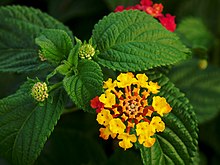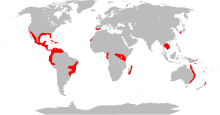| Lantana camara[1] | |
|---|---|

| |
| Flowers and leaves | |
| Scientific classification | |
| Kingdom: | Plantae |
| Clade: | Tracheophytes |
| Clade: | Angiosperms |
| Clade: | Eudicots |
| Clade: | Asterids |
| Order: | Lamiales |
| Family: | Verbenaceae |
| Genus: | Lantana |
| Species: | L. camara
|
| Binomial name | |
| Lantana camara | |

| |
| Global distribution of Lantana camara | |
| Synonyms | |
Lantana camara (common lantana) is a species of flowering plant in the verbena family (Verbenaceae), native to the American tropics.[5][6] It is a very adaptable species, which can inhabit a wide variety of ecosystems; once it has been introduced into a habitat it spreads rapidly; between 45ºN and 45ºS and less than 1,400 metres (4,600 feet) in altitude.
It has spread from its native range to around 50 countries,[7] where it has become an invasive species.[8][9] It first spread out of the Americas when it was brought to Europe by Dutch explorers and cultivated widely, soon spreading further into Asia and Oceania where it has established itself as a notorious weed, and in Goa Former Estado da Índia Portuguesa it was introduced by the Portuguese.[8]
L. camara can outcompete native species,[10] leading to a reduction in biodiversity.[11] It can also cause problems if it invades agricultural areas as a result of its toxicity to livestock, as well as its ability to form dense thickets which, if left unchecked, can greatly reduce the productivity of farmland[12] by suppressing the pastures (grasses) essential for livestock production and also suppresses crops in cultivated farmlands.[1]
- ^ Munir A (1996). "A taxonomic review of Lantana camara L. and L. montevidensis (Spreng.) Briq. (Verbenaceae) in Australia". Journal of the Adelaide Botanic Gardens. 17: 1–27.
- ^ "NatureServe Explorer".
- ^ "Lantana aculeta L." U.S National Plant Germplasm System (NPGS). Retrieved January 6, 2019.
- ^ "Global Invasive Species Database". issg.org.uk. Archived from the original on 2014-04-07. Retrieved 2014-03-22.
- ^ Floridata LC (2007). "Lantana camara". Floridata LC. Retrieved March 24, 2014.
- ^ Moyhill Publishing (2007). "English vs. Latin Names". Moyhill Publishing. Retrieved March 24, 2014.
- ^ Day, M. D. (December 24, 2003). Lantana: current management status and future prospects. Australian Centre for International Agricultural Research. ISBN 978-1-86320-375-3. Retrieved March 24, 2014.
- ^ a b Ghisalberti, E.L. (2000). "Lantana camara L. (Verbenaceae)". Fitoterapia. 71 (5): 467–486. doi:10.1016/S0367-326X(00)00202-1. PMID 11449493.
- ^ Sharma, OM.P.; Harinder, Paul S (1988). "A review of the noxious plant Lantana camara". Toxicon. 26 (11): 975–987. doi:10.1016/0041-0101(88)90196-1. PMID 3072688.
- ^ Kasaga, Lawrence (March 2022). Impact of Lantana camara on native vegetation structure and diversity of Kakiika, Mbarara, Uganda (BSc thesis). Makerere University. doi:10.13140/RG.2.2.31037.95206. Retrieved 23 December 2022.
- ^ Kohli, Ravinder. K. (2006). "Status, invasiveness and environmental threats of three tropical American invasive weeds (Parthenium hysterophorus L., Ageratum conyzoides L., Lantana camara L.) in India". Biological Invasions. 8 (7): 1501–1510. Bibcode:2006BiInv...8.1501K. doi:10.1007/s10530-005-5842-1. S2CID 23302783.
- ^ Ensbey, Rob. "Lantana - Weed of National Significance".
